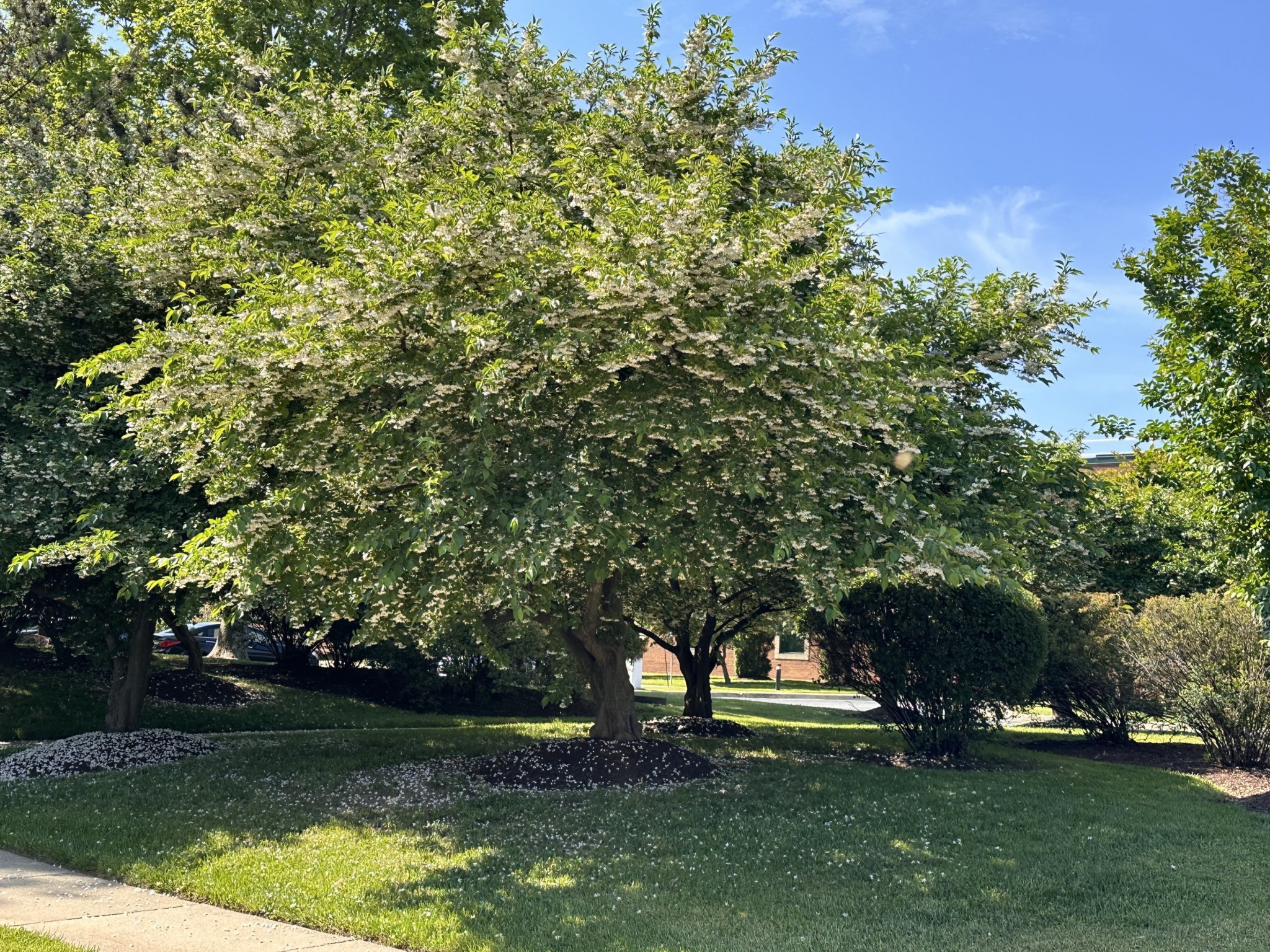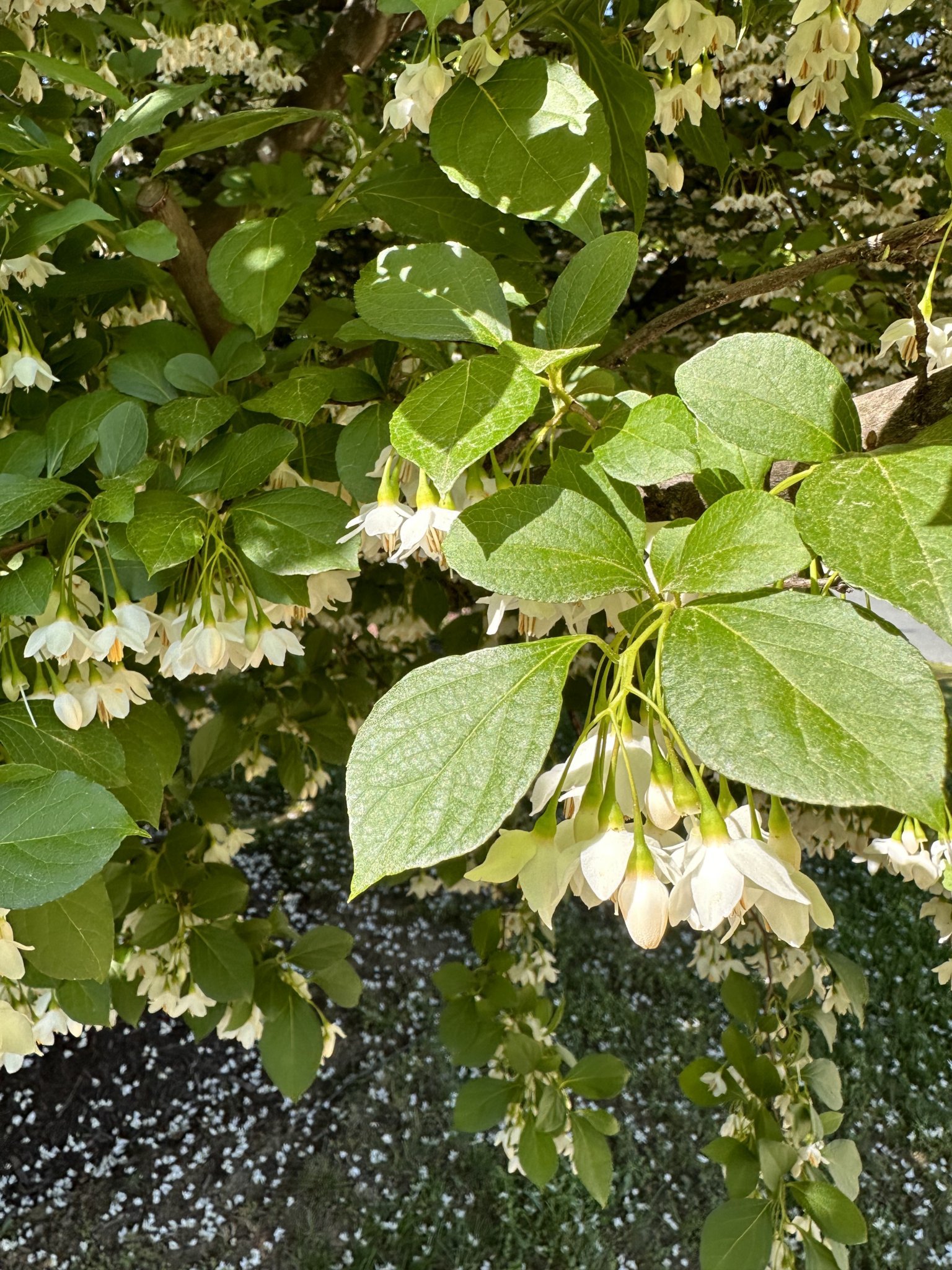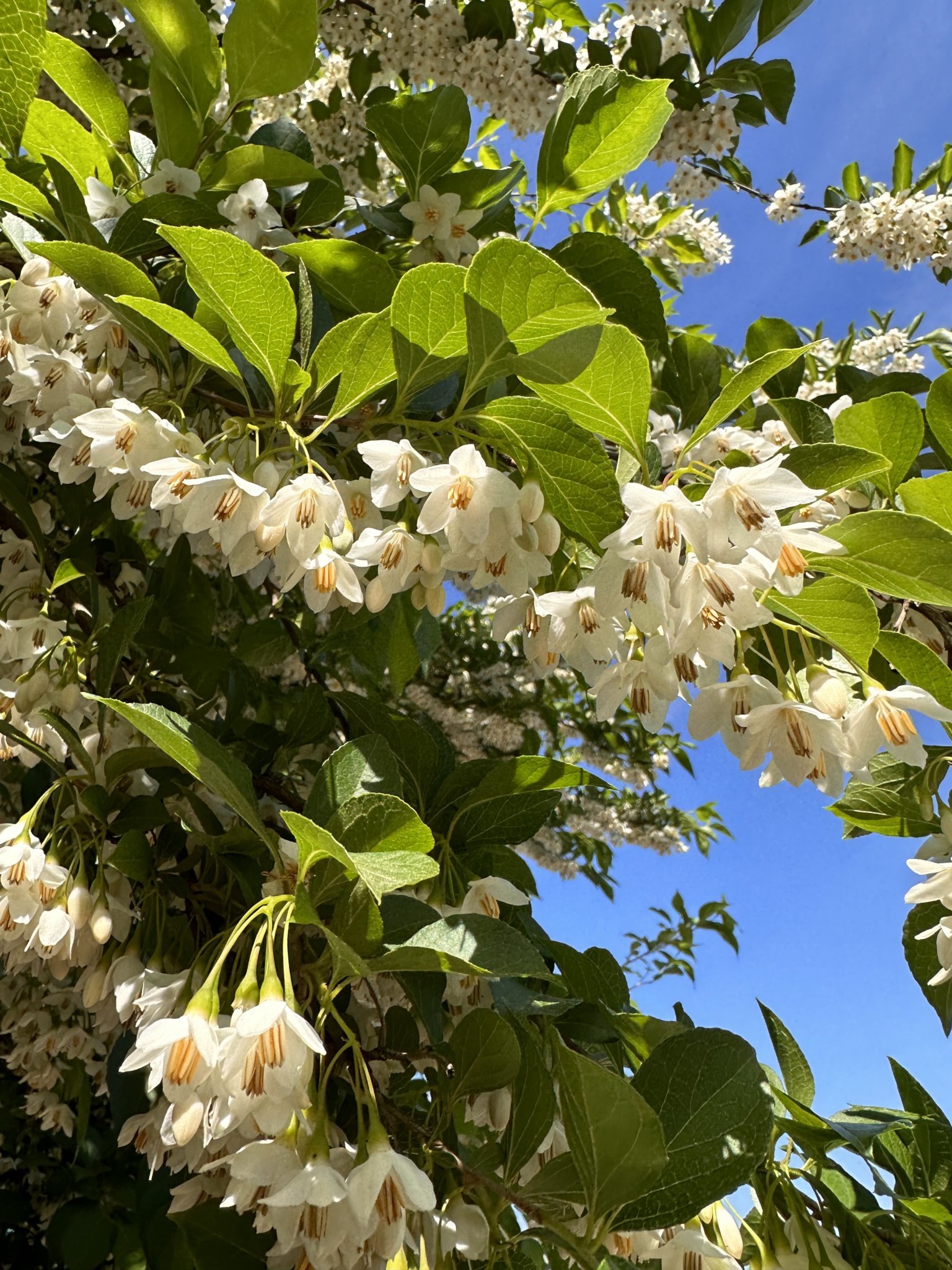Japanese Snowbell Tree
A Small, Spring-flowering Tree for Zones 5 - 9
Nature's confetti: Japanese snowbell petals decorate the ground.
Styrax japonicus, commonly known as the Japanese snowbell tree, is a deciduous ornamental tree native to East Asia. This exquisite tree is prized for its dainty, bell-shaped flowers and glossy green foliage. Several cultivars are available in different shapes, sizes, and colors, making this a versatile choice for gardens of all sizes in zones 5-9.
Pendulous clusters of fragrant, bell-shaped white flowers bloom from late spring to early summer. The delicate, waxy petals of these blossoms resemble a cascade of pristine snowflakes, giving the tree its common name. Japanese snowbell trees typically reach a modest height of 20 to 30 feet high and wide, making them suitable for both small and large gardens. With their attractive, dark green leaves and smooth gray-brown bark, these trees offer year-round visual interest.
How to Care for a Japanese Snowbell Tree
Japanese snowbell thrives in well-drained, moist, acidic soil and full sun to partial shade. Regular watering is essential! Japanese snowbell does not tolerate periods of heat and drought, and should be watered deeply on a regular basis. Mulching around the base of the tree can help retain moisture and suppress weeds, and using a soaker hose to deeply water can be an effective and efficient method. For more information about watering, click here.
Japanese snowbell trees have a moderate growth rate when young, up to 3 feet per year, with growth slowing down after 10 years. Twig dieback, a condition where the tree’s smaller branches start to die off, can be an occasional problem. Prune sparingly to remove dead or damaged branches - this tree’s natural horizontal branching pattern is graceful and excessive pruning can detract from its beauty. Japanese snowbell trees are relatively unbothered by pests and diseases, and will occasionally be browsed by deer when other food resources are not available.
Are Japanese Snowbell Trees Messy or Invasive?
After Japanese Snowbell trees bloom, their small flower petals eventually drop from the tree, creating a carpet of petals on the ground. While this can be considered a form of natural beauty, some people may find it slightly messy. After flowering, seeds have the potential to disperse and establish themselves in the surrounding environment - exercise caution when planting near natural or wild areas.
Japanese Snowbell is considered invasive by the State of New Jersey, and should not be confused with the Japanese Snowball viburnum (Viburnum plicatum f. tomentosum), a rapidly spreading and widely invasive shrub.
The waxy, bell-shaped flowers of Japanese snowbell tree (Styrax japonicus) resemble cascading snowflakes.
Landscape Design Ideas for Japanese Snowbell
Plant Japanese snowbell as an accent or single specimen tree, in a place where the delicate spring flowers can be appreciated. It makes an ideal patio tree or lawn specimen. Plant on a hillside or slope, where the bell-shaped flowers can be viewed from below. The small, compact size of this tree makes it the perfect addition to any mixed border or mixed privacy screen. Its compact size and salt tolerance makes it suitable for use as a street tree, especially in areas with overhead utility lines or limited space. Japanese snowbell must be sited where it has consistently moist, well-draining soil - it will not tolerate heat and drought.
Smooth, gray-brown bark gives Japanese snowbell year-round appeal.
Japanese Snowbell Cultivars with White Flowers
‘Carillon’ grows 8-12 feet high and has a spreading, weeping form.
‘Emerald Pagoda’ (also called ‘Sohuksan’) has larger, dark green leaves, white flowers and a greater tolerance to heat. Vase-shaped and grows to 30 feet high and 20 feet wide.
‘Evening Light’ has deep maroon leaves and white flowers; grows 20-25 feet tall and 15 feet wide with a bell-shaped form.
‘Fragrant Fountains’ has a graceful, tight weeping form and grows 12 feet tall and 7 feet wide; suitable for large containers.
‘Issai’ is a free flowering cultivar with white blooms; fast growing to 30 feet tall and 20 feet wide.
Nightfall® ‘JFS 6SJ' grows in a weeping form, 8 feet tall and 6 feet wide, with dark purple-green leaves and creamy white flowers.
‘Snow Charm’ has a rounded habit and grows 20 feet high and wide, with white flowers and dark green leaves. Resistant to twig dieback.
‘Snowcone’ has dark green leaves, white flowers and a conical shape. Grows 25 feet high and 20 feet wide.
Japanese Snowbell Cultivars with Pink Flowers
‘Marley's Pink Parasol® ‘JLWeeping' has larger, glossy, dark green leaves, a weeping form, a profusion of blush pink flowers and bright yellow fall color. Grows 8-10 feet high with a spread of 4-5 feet.
‘Pink Chimes’ is an upright shrub to small tree with pale pink flowers, growing 10-25 feet tall.
‘Pink Trinket’ is a dwarf shrub, with pink flowers and a dense shape. Grows 4 feet high and 3 feet wide.
Does the Spotted Lanternfly kill Japanese Snowbell Trees?
The spotted lanternfly is native to China, and is classified as an invasive insect pest in the United States. It was first identified in Pennsylvania in 2014 and is quickly spreading throughout the eastern part of the country. This destructive pest is actually quite beautiful, with elegant black-spotted gray forewings and red, white and black hind wings (read more about identification of adult and nymph spotted lanternflies on Cornell University’s website).
Spotted lanternflies feed on the sap of a variety of different plants, including economically significant agricultural crops such as grapes, apples, and stone fruit trees. In commercial agriculture the impact of spotted lanternfly can be quite severe. Their feeding can weaken these plants, making them more susceptible to diseases and other environmental stresses.
Spotted lanterfly nymph (photo credit: Matthew Martin)
Spotted lanternflies have been observed feeding on Japanese snowbell trees, clustering in masses on the trunk and secreting honeydew, a sugary substance that attracts other pests and promotes the growth of sooty mold. In residential yards and gardens, spotted lanternflies are considered to be merely a nuisance. They do not kill trees, but may stress and weaken them. They do not bite and pose no threat to the health of people or pets. They do not bore into homes or wooden structures. For Japanese snowbell trees affected by spotted lanternflies, proper watering, maintaining soil health, and proper mulching are crucial for helping the tree to stay strong until the insects move somewhere else (infestations tend to be short-lived), or die from cold weather.
If you have spotted lanterflies on your Japanese snowbell tree or in your yard, the recommended approach is to use physical and mechanical methods to kill the pests. Insecticide treatments for part or all of the yard are not recommended - you are only making a temporary dent in the population while putting a variety of other organisms at risk, including yourself and your pets. Instead of reaching for chemicals, try these methods:
Manual removal: simply picking off and squashing spotted lanternflies is an effective method, especially for smaller infestations. This approach requires vigilance and consistent effort.
Traps: placing sticky traps around affected areas can help capture spotted lanternflies. These traps can be purchased or made at home using materials like sticky tape or glue boards.
Vacuuming: using a handheld vacuum can be an efficient way to capture and dispose of spotted lanternflies. Empty the vacuum bag or canister carefully to prevent them from escaping.
Tree banding: wrapping tree trunks with sticky bands or tape can trap nymphs as they crawl up and down the trees. This method is especially effective during the nymph stage.
Crushing egg masses: In the fall and winter, inspect trees and surfaces for spotted lanternfly egg masses. Scraping off and destroying these masses can help reduce the population in the following season.








